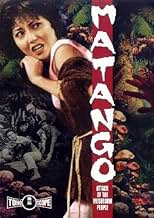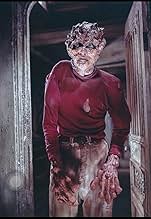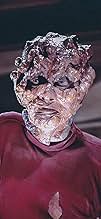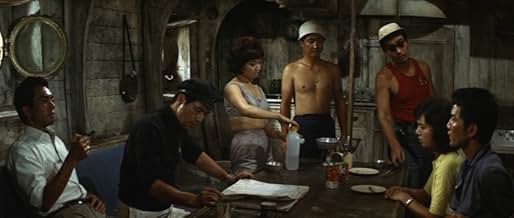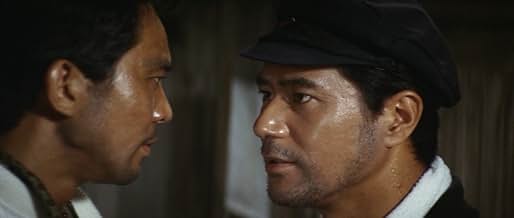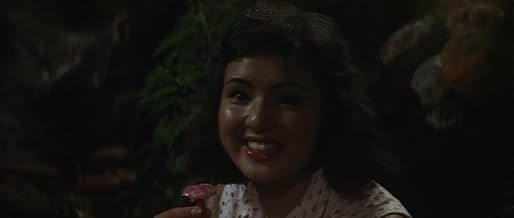CALIFICACIÓN DE IMDb
6.4/10
3.8 k
TU CALIFICACIÓN
Los sobrevivientes de un naufragio comienzan a perder su humanidad al consumir los hongos de la isla.Los sobrevivientes de un naufragio comienzan a perder su humanidad al consumir los hongos de la isla.Los sobrevivientes de un naufragio comienzan a perder su humanidad al consumir los hongos de la isla.
- Dirección
- Guionistas
- Elenco
Takuzô Kumagai
- Doctor
- (as Jirô Kumagai)
Opiniones destacadas
I have noticed that many of the commentators in this forum have stated that this film gave them nightmares. No wonder. This film based on William Hope Hodgson's novel "The Voice in the Night", has a plot that is so bizarre that it could only have been inspired by someone's nightmares. The premise of intelligent fungus luring people to eat them and then the people slowly turn to "mushroom people" is so nightmarishly creepy that I can't imagine that Hodgson (or anyone else) could of dreamed this idea up when he was wide awake.
MATANGO (aka ATTACK OF THE MUSHROOM PEOPLE) is a surprisingly low key atmospheric Japanese horror fantasy. The film is a bit slowly paced at times and too much time is spent on the castaways bickering amongst themselves. There are some elements that I suspect were better developed in the novel. One scene has the two female castaways hearing the voices of dead relatives trying to lure them into the rainforest. This never occurs again and leads nowhere. I'm sure the stuff about nuclear experiments was not in Hodgson's novel. However, the art direction is excellent, the music creepy and the final sequence memorable. Overall, the boys at Toho did a good job.
I don't care what the Medvids think of this film, or the pseudo hip MST3K crowd thinks either, your old pal jim says, see this one.
MATANGO (aka ATTACK OF THE MUSHROOM PEOPLE) is a surprisingly low key atmospheric Japanese horror fantasy. The film is a bit slowly paced at times and too much time is spent on the castaways bickering amongst themselves. There are some elements that I suspect were better developed in the novel. One scene has the two female castaways hearing the voices of dead relatives trying to lure them into the rainforest. This never occurs again and leads nowhere. I'm sure the stuff about nuclear experiments was not in Hodgson's novel. However, the art direction is excellent, the music creepy and the final sequence memorable. Overall, the boys at Toho did a good job.
I don't care what the Medvids think of this film, or the pseudo hip MST3K crowd thinks either, your old pal jim says, see this one.
When I first saw this film on a local late-night horror movie show, it was the late 1960s and our family hadn't yet purchased a color TV. Growing up with films and TV shows produced and viewed in B&W made me sensitive to the unique qualities of this medium, particularly the way in which it focuses the viewer's attention on the quality and play of light. It is this element of "Matango" which most impressed methe cold ethereal light of the fog-shrouded forest covered in great lumps of pallid fungus sent a real shiver down my back. Although I had cut my teeth on such midnight horror movies, this one actually stole away my sleep for a couple nights!
Over time I had lost track of this film. The Saturday Night horror show became a thing of the past and no one seemed interested in rebroadcasting these old films. Then very recently, on a lark, I asked our local (independent) video rental place if they had this film in their data base, and Lo! there it was, available on VHS. They ordered it, held it for me, I rented it and prepared to sit down and be scared by it again after a hiatus of over 25 years.
Imagine my surprise to find that the film is in color! In color, it didn't have the same impact at all as it did when I watched it on our B&W TV back home. Quickly, before it got too deep into the story, I changed all the settings on my TV to a nicely balanced black and white, and WOW! There it was, the scariness, the moodiness, the mystery, and the visual subtleties which make it a very nice piece of art.
Really, folksyou gotta see this film in black and white to really appreciate how well it was photographed, lighted, constructed and dressed. This is quite a gem of a film, but one which should have been in black and white to begin with.
Over time I had lost track of this film. The Saturday Night horror show became a thing of the past and no one seemed interested in rebroadcasting these old films. Then very recently, on a lark, I asked our local (independent) video rental place if they had this film in their data base, and Lo! there it was, available on VHS. They ordered it, held it for me, I rented it and prepared to sit down and be scared by it again after a hiatus of over 25 years.
Imagine my surprise to find that the film is in color! In color, it didn't have the same impact at all as it did when I watched it on our B&W TV back home. Quickly, before it got too deep into the story, I changed all the settings on my TV to a nicely balanced black and white, and WOW! There it was, the scariness, the moodiness, the mystery, and the visual subtleties which make it a very nice piece of art.
Really, folksyou gotta see this film in black and white to really appreciate how well it was photographed, lighted, constructed and dressed. This is quite a gem of a film, but one which should have been in black and white to begin with.
Toho are mostly known for their dark bleak period pieces and their goofy monster flicks, but every once in a while they delved into something else and Matango is a great example of this.
Well ahead of its time it tells the story of ship wreck survivors trying to make it until help comes, but they don't appear to be alone on the island and tensions are beginning to build.
So okay I admit the concept is daft, the antagonists are a bit silly but lets be honest they aren't a million miles from those in The Last of Us (2013). Despite this they actually do the job quite well and look considerably better than you'd imagine considering this was the early 60's.
The film is a real slow burner and very little of it features the antagonists at all, the majority is the turmoil between survivors but it does this to a passable degree.
Though not everything it could have been there is a lot to be impressed over in Matango and it's a neat little forgotten Toho movie that deserves attention.
The Good:
Looks excellent for its time
Some good ideas
The Bad:
Cast and characters are pretty forgettable
Very slow burn
Things I Learnt From This Movie:
An opportune time to tell a woman you love her for the first time is straight after hitting her
Could easily have had a sequel about killer cheese people
Well ahead of its time it tells the story of ship wreck survivors trying to make it until help comes, but they don't appear to be alone on the island and tensions are beginning to build.
So okay I admit the concept is daft, the antagonists are a bit silly but lets be honest they aren't a million miles from those in The Last of Us (2013). Despite this they actually do the job quite well and look considerably better than you'd imagine considering this was the early 60's.
The film is a real slow burner and very little of it features the antagonists at all, the majority is the turmoil between survivors but it does this to a passable degree.
Though not everything it could have been there is a lot to be impressed over in Matango and it's a neat little forgotten Toho movie that deserves attention.
The Good:
Looks excellent for its time
Some good ideas
The Bad:
Cast and characters are pretty forgettable
Very slow burn
Things I Learnt From This Movie:
An opportune time to tell a woman you love her for the first time is straight after hitting her
Could easily have had a sequel about killer cheese people
First of all, it takes guts on the part of the filmmakers to make a commercial movie about people turning into giant mushrooms. It's all a big modern morality fable. Once the characters get to the island, we the audience are sucked into a horrific world of constant rain where the only food that grows is fungus. The characters try to resist but most eventually give in to the temptation. This film is very creepy and maintains an atmosphere of dread. Even the final evolution of the mushroom people is convincing enough to keep you wrapped up in it. It starts off slow but give it a chance. It's a beautifully made and memorable little masterpiece of horror that rightfully seems to have been born of nightmares. It's too bad that even in our supposedly enlightened, politically tolerant world that there is no American distributor for the uncut Japanese version of this film. This film is hard to locate but well worth the effort. I even saw the American International Pictures version that is badly dubbed and it is still a powerful and original film. See it at all costs if you are a fan of Japanese horror films.
10Kabumpo
The cast of this film all consider it one of their proudest achievements. This film is about false friendships, utter hatred, and abandonment of values. Constructed from William Hope Hodgson's rather simple horror story, in which a man hailing a schooner for food tells how the virtuous (abstinent) unmarried couple (himself and his fiancee) were in a shipwreck and tried to make their home on an island encrusted with fungus, first in a ship and then in two tents on an unidentified sandy substance, only to eat the fungus and become it, takes on a whole new dimension by placing the man, here a psychology professor, and his student fiancee with a rich couple together only for the money, a serious writer, and the two-man crew. Though they never abandon the fungus-encrusted ship for tents, they soon become embittered over food, and the men all want the virgin, not the rich showgirl. Hodgson was on the way to becoming a minister before he was killed in WWI, and his story is explicitly Christian. This film takes out explicit religion (though the Japanese version has a brief scene related to Akiko's Shinto beliefs, which was deleted because most Americans wouldn't understand it), but retains the morals. The psychologist is unable to cope with the degrading values, particularly after the mate is shot over money (useless) and turtle eggs (food). The skipper takes the ship (which isn't his, Kasai wearing a captain's uniform to prove it (and how stuck up he is)) after repairing it, without anyone else, but he dies at sea, Murai soon finding the abandoned ship. The voyage reveals the true character of the relationships with one another, and their attempts to break down the virtuous couple, which ends with the psychologist in the asylum, where he tells his story. He gets succumbed, too. "My friends are alive; I'm the one who died," he tells them. The crew dead, his friends are left on the island, slowly merging with the fungus...
¿Sabías que…?
- TriviaThe film was nearly banned in Japan. The makeup some characters wore as they were turning into humanoid mushroom creatures was very similar to how many Japanese people looked after the atomic bombings of Hiroshima and Nagasaki.
- ErroresWhen Kasai shoots at Yoshida and Mami as he chases them off the boat, you can see the bullets ricochet off the ground before he even fires a shot.
- Créditos curiososThe opening credits of the Japanese version are on animated sailboat sails.
- ConexionesEdited into Gli ultimi giorni dell'umanità (2022)
Selecciones populares
Inicia sesión para calificar y agrega a la lista de videos para obtener recomendaciones personalizadas
- How long is Matango?Con tecnología de Alexa
Detalles
- Fecha de lanzamiento
- País de origen
- Idioma
- También se conoce como
- Attack of the Mushroom People
- Locaciones de filmación
- Productora
- Ver más créditos de la compañía en IMDbPro
- Tiempo de ejecución1 hora 29 minutos
- Mezcla de sonido
- Relación de aspecto
- 2.55 : 1
Contribuir a esta página
Sugiere una edición o agrega el contenido que falta


